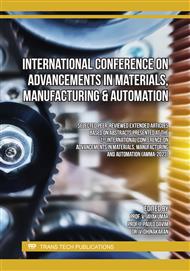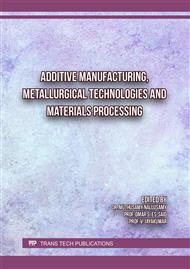[1]
J. Hammer, M. H. S. Kraak, and J. R. Parsons, "Plastics in the marine environment: The dark side of a modern gift," Reviews of Environmental Contamination and Toxicology, vol. 220. p.1–44, 2012.
DOI: 10.1007/978-1-4614-3414-6_1
Google Scholar
[2]
H. K. Webb, J. Arnott, R. J. Crawford, and E. P. Ivanova, "Plastic degradation and its environmental implications with special reference to poly(ethylene terephthalate)," Polymers (Basel), vol. 5, no. 1, p.1–18, 2013.
DOI: 10.3390/polym5010001
Google Scholar
[3]
K. Mikula et al., "3D printing filament as a second life of waste plastics-a review".
Google Scholar
[4]
G. Colucci, H. Simon, D. Roncato, B. Martorana, and C. Badini, "Effect of recycling on polypropylene composites reinforced with glass fibres," Journal of Thermoplastic Composite Materials, vol. 30, no. 5, p.707–723, May 2017.
DOI: 10.1177/0892705715610407
Google Scholar
[5]
A. Rahimizadeh, J. Kalman, K. Fayazbakhsh, and L. Lessard, "Recycling of fiberglass wind turbine blades into reinforced filaments for use in Additive Manufacturing," Compos B Eng, vol. 175, Oct. 2019.
DOI: 10.1016/j.compositesb.2019.107101
Google Scholar
[6]
M. I. Mohammed, D. Wilson, E. Gomez-Kervin, B. Tang, and J. Wang, "Investigation of Closed-Loop Manufacturing with Acrylonitrile Butadiene Styrene over Multiple Generations Using Additive Manufacturing," ACS Sustain Chem Eng, vol. 7, no. 16, p.13955–13969, Aug. 2019.
DOI: 10.1021/acssuschemeng.9b02368
Google Scholar
[7]
I. Ferreira, D. Vale, M. Machado, and J. Lino, "Additive manufacturing of polyethylene terephthalate glycol /carbon fiber composites: An experimental study from filament to printed parts," Proceedings of the Institution of Mechanical Engineers, Part L: Journal of Materials: Design and Applications, vol. 233, no. 9, p.1866–1878, Sep. 2019.
DOI: 10.1177/1464420718795197
Google Scholar
[8]
M. Heidari-Rarani, M. Rafiee-Afarani, and A. M. Zahedi, "Mechanical characterization of FDM 3D printing of continuous carbon fiber reinforced PLA composites," Compos B Eng, vol. 175, Oct. 2019.
DOI: 10.1016/j.compositesb.2019.107147
Google Scholar
[9]
S. C. Dertinger et al., "the Creative Commons Attribution-NonCommercial-NoDerivatives 4.0 International http://creativecommons.org/about/downloads Technical Pathways for Distributed Recycling of Polymer Composites for Distributed Manufacturing: Windshield Wiper Blades," 2020.
DOI: 10.1016/j.resconrec.2020.104810
Google Scholar
[10]
M. Theses Dissertations and R. Zou, "ScholarWorks@UMass Amherst ScholarWorks@UMass Amherst Design for Sustainability through a Life Cycle Assessment Design for Sustainability through a Life Cycle Assessment Conceptual Framework Integrated within Product Lifecycle Conceptual Framework Integrated within Product Lifecycle Management Management," 2018.
DOI: 10.1108/978-1-78714-561-020181010
Google Scholar
[11]
Y. Aryan, P. Yadav, and S. R. Samadder, "Life Cycle Assessment of the existing and proposed plastic waste management options in India: A case study," J Clean Prod, vol. 211, p.1268–1283, Feb. 2019.
DOI: 10.1016/j.jclepro.2018.11.236
Google Scholar
[12]
A. L. Woern, J. R. McCaslin, A. M. Pringle, and J. M. Pearce, "RepRapable Recyclebot: Open source 3-D printable extruder for converting plastic to 3-D printing filament," HardwareX, vol. 4, Oct. 2018.
DOI: 10.1016/j.ohx.2018.e00026
Google Scholar
[13]
M. A. Osman and M. R. A. Atia, "Investigation of ABS-rice straw composite feedstock filament for FDM," Rapid Prototyp J, vol. 24, no. 6, p.1067–1075, Oct. 2018.
DOI: 10.1108/RPJ-11-2017-0242
Google Scholar
[14]
V. Gaikwad, A. Ghose, S. Cholake, A. Rawal, M. Iwato, and V. Sahajwalla, "Transformation of E-Waste Plastics into Sustainable Filaments for 3D Printing," ACS Sustain Chem Eng, vol. 6, no. 11, p.14432–14440, Nov. 2018.
DOI: 10.1021/acssuschemeng.8b03105
Google Scholar
[15]
S. Zhong, J. Pearce, J. P. Tightening, and J. M. Pearce, "RepRap 3-D printing,Resources, Conservation and Recycling 128," p.48–58, 2018.
DOI: 10.1016/j.resconrec.2017.09.023
Google Scholar
[16]
M. J. Reich, A. L. Woern, N. G. Tanikella, and J. M. Pearce, "Mechanical properties and applications of recycled polycarbonate particle material extrusion-based additive manufacturing," Materials, vol. 12, no. 10, May 2019.
DOI: 10.3390/ma12101642
Google Scholar



